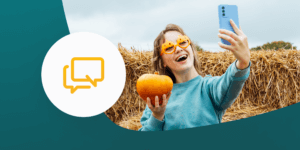
A Beginner’s Guide to SMS Marketing
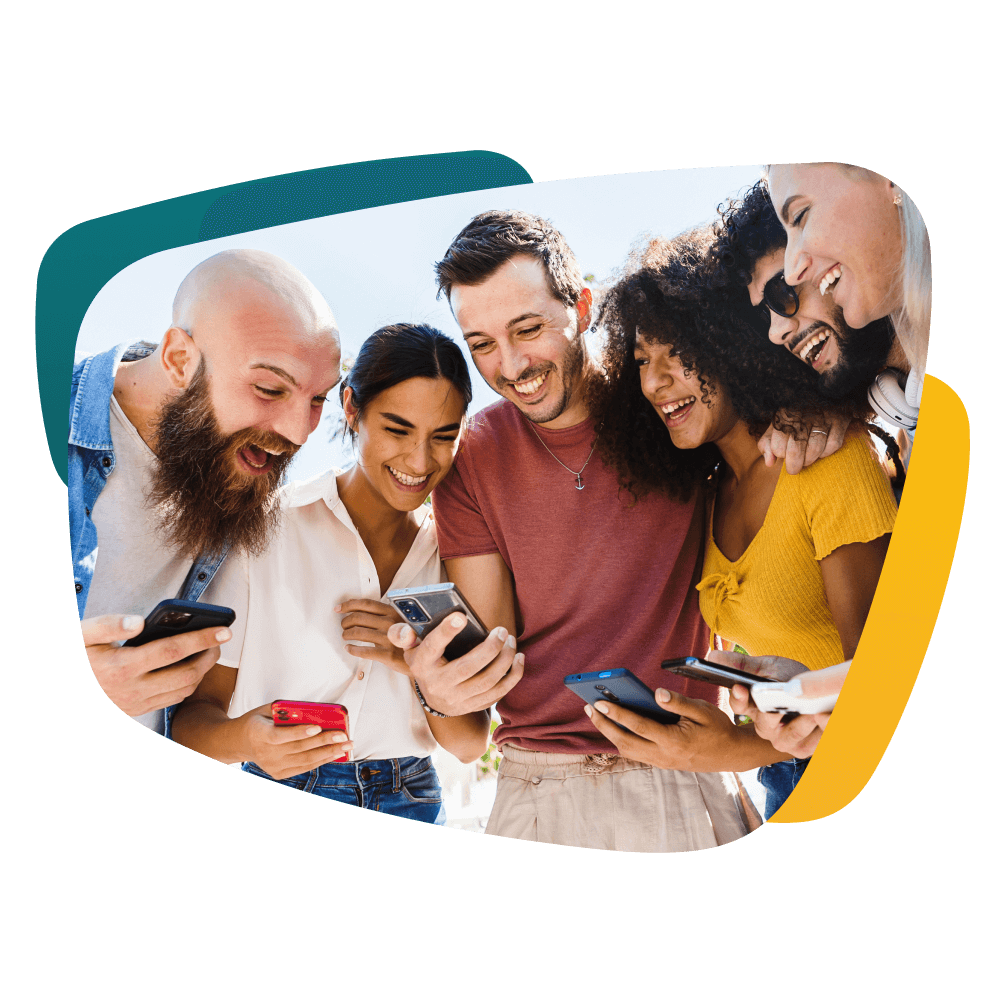
“Sales increased by 32% the day after we sent the messages.”
“We sent an email campaign out and only got 70 or so clicks. When we sent the text message out we got 11,200 clicks.”
“My weekly takings are up and I am now looking for more delivery drivers. This can only be down to the extra customers that we have won.”
Those are real quotes from small business owners talking about SMS marketing.
In this guide you’ll learn why this marketing tactic delivers those kinds of results and how you can use it to achieve the same for your business.
Let’s dig in.
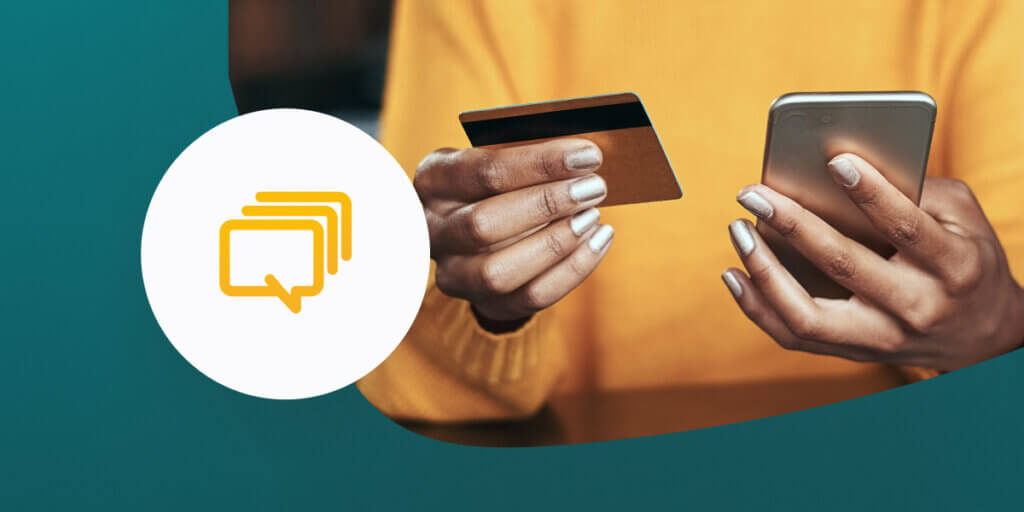
What is SMS marketing?
Short message service (SMS) marketing is a type of mobile marketing that businesses use to send text messages to customers.
Also called text marketing or message marketing, it’s a fast, direct way of reaching people with promotional offers, company updates, order information, reminders, and more. And it’s a proven tactic. Businesses that text customers are 217% more successful than those that don’t. Plus, 90% of businesses that use text marketing say it works.
Like email marketing, SMS marketing is opt-in marketing. This means you need a contact’s permission to send messages.
Opt-in gives SMS an advantage over social marketing or search engine marketing where content is public and people choose what to engage with.
Why?
Because opt-in is a green light that shows customers want to hear from you. Better still, they want to hear from you via text. Research shows that 48% of consumers prefer text messaging to any other communication channel. And given the choice between receiving a text or a phone call, 90% of consumers choose text. So when your SMS pings a phone, the recipient is more likely to read and respond to it. Which leads us nicely on to answering the next question.
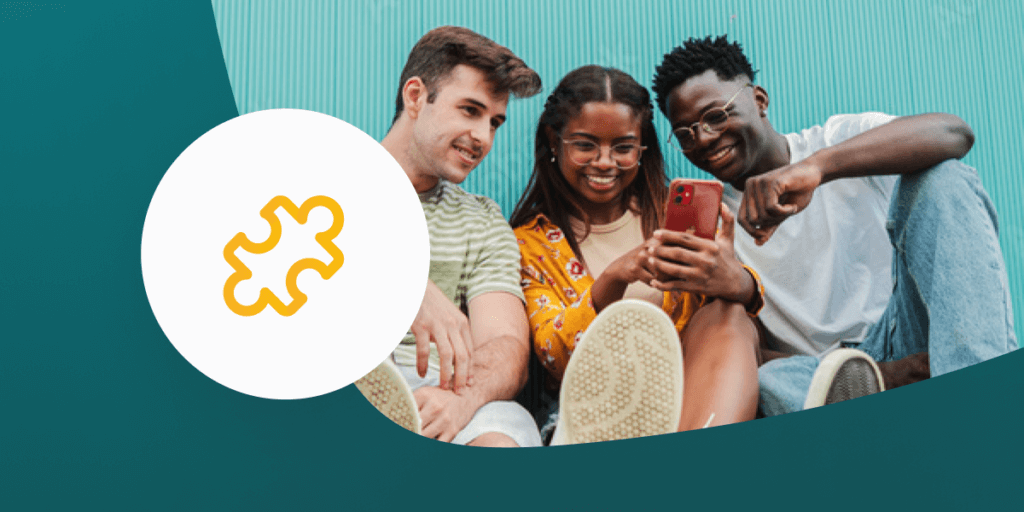
Why is SMS marketing effective?
SMS marketing works because it’s familiar and accessible.
Mobile phones have been commonplace for over two decades (closer to three).
93% of UK households own one and collectively we spend an average of 3 hours 46 minutes a day using them. We’re attached to our phones like no other device.
If you want to know how attached, try leaving home without your phone. That feeling like you’ve lost a limb? That plays an important part in the success of text marketing.
Simply put: SMS puts your message in the customer’s hand.
And it doesn’t rely on an internet connection or app download to do it. So every phone with a working SIM card can opt-in—smart or otherwise.
The result?
High open rates
Marketing texts have a 98% average open rate. This means almost everyone who receives a text message opens and views it.
That’s 5x the average open rate of email (21.33%). So, there’s a much higher chance of a customer seeing your text than your email.
There are a couple of reasons for this:
1. Directness. A text message is delivered in seconds (three, on average) and immediately pings the recipient to notify them. Emails rely on an internet connection and require you to open an app to view messages.
2. Noise. Email inboxes are crowded (the commonly cited stat is that the average person receives 121 emails a day). By comparison, a text message inbox is much less chaotic. It tends to be reserved for people (and businesses) you’re close to. So, messages are less likely to go unnoticed.
High response rates
An SMS marketing message never goes unread for long. 90% of texts are read within three minutes and 97% are read within 15 minutes.
People act on what they read too. Research shows SMS has a response rate of 45%, compared to a response rate of 6% for emails.
And they respond fast—within 90 seconds of reading on average, compared to 90 minutes for email.
If you include a link in your text message, 28-33% of recipients click on it. That’s 6x higher than email.
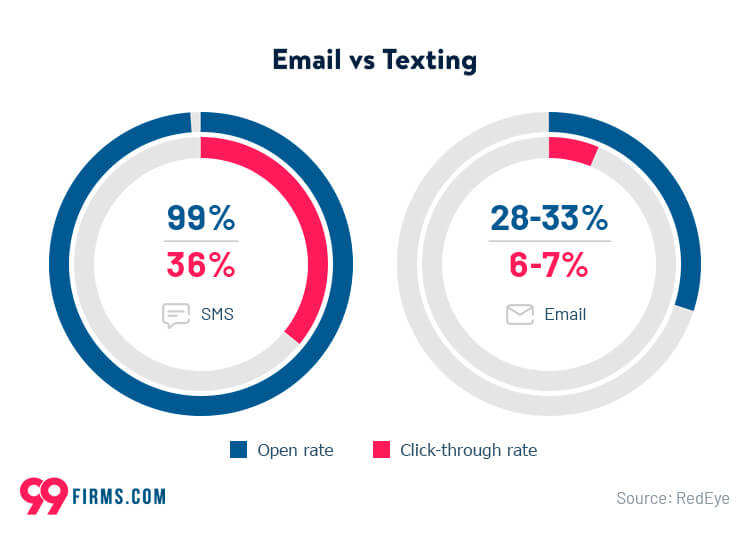
Why are people happy to engage with texts?
Because they’re easy to read and reply to. They promote one-to-one conversation, which makes them great for building more personal, loyal relationships with customers.
And a loyal customer is a valuable one. They spend more money, recommend you more, and are more likely to try your new products or services.
High conversion rate
The average conversion rate for SMS marketing is 29%. This means nearly a third of people opening, reading and responding to your messages go on to complete an action. For example, buy a product or service, enter your competition or sign up for your loyalty program.
As we’re in the habit of comparing SMS rates to email, the average conversion rate for those who click through from that channel is 15.22%.
SMS looks even more impressive when compared to Google Ads (7.04%) and Facebook Ads (9.21%).
Cost-effective marketing
SMS marketing lets you reach a lot of people for a relatively small outlay. For example, sending your first campaign to 10,000 customers on Text Marketer costs £250.*
The more texts you send, the lower the per-text rate becomes. And that rate is all you pay. The tools to send texts and track performance tend to be free (or they are with Text Marketer).
It’s worth mentioning that many email and ad platforms work in a similar way too—pay-per-subscriber or user and pay-per-click respectively.
But when it comes to value for money, the high engagement rate means SMS takes some beating.
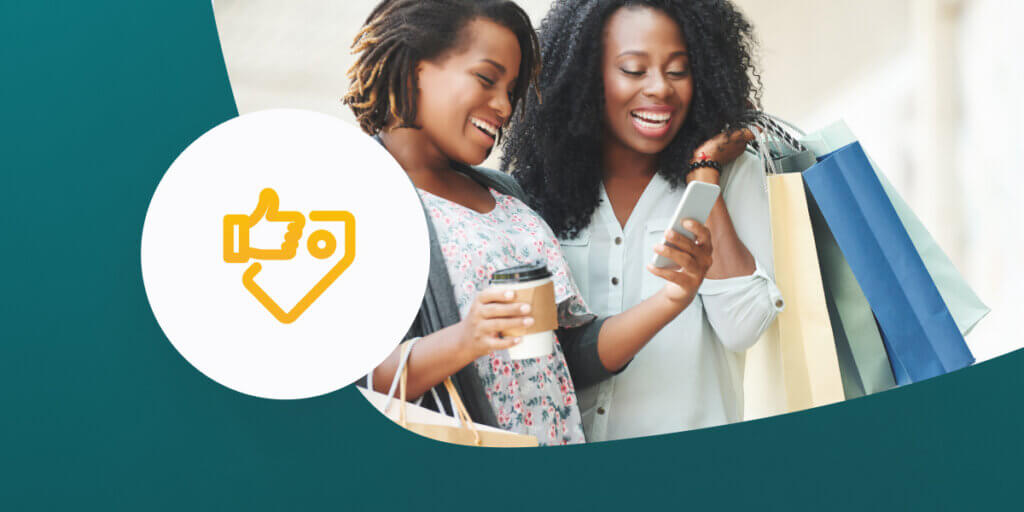
Is SMS marketing legal?
In short, yes—SMS marketing is perfectly legal.
But it’s a regulated industry and there are rules you need to follow to stay on the right side of the law, or more accurately, laws.
There are five different regulations and organisations, you need to abide by:
- General Data Protection Regulation (GDPR)
- Privacy and Electronic Communications Regulations
- The Data Protection Act 2018
- Information Commissioner’s Office (ICO)
- Advertising Standards Authority
You also need to follow the terms and conditions of mobile networks.
Each of these has its own requirements and way of wording the dos and don’ts that can make it all seem overwhelming.
Thankfully, we can distil them down into five key rules:
1. You must get consent from a person before sending them a message
In other words, they must opt-in to receiving marketing texts. Consent has to be:
- Freely given. A person should have free choice over whether to opt in. For example, if you use a checkbox, it can’t be pre-checked.
- Specific. Consent must be unique to SMS marketing. For example, if your customer opts in to receive emails, this doesn’t qualify you to send them text messages and vice-versa.
- Informed. A person should know what they’re opting in for. Details on what you’ll send and the information you collect should be clear and easy to understand.
When collecting consent, include links to your Privacy Policy and Terms of Service to show customers what is shared and how it’s used.
2. You must make it easy for people to opt out and promptly process requests
If a customer decides they no longer want to receive your texts, don’t make them jump through hoops.
The simplest way to offer an opt-out is to include it in your text, either with a short code (a chosen keyword linked to a five or six digit number), link or contact number.
For example:
- Reply STOP to 12345
- Click this link to unsubscribe
- To unsubscribe call our customer service team on [number]

3. You must clearly share your identity in text messages so the recipient know it’s you
A nameless message qualifies as spam, which means it might be flagged by a mobile network.
To avoid this, always include a Sender ID. This can be alphanumeric or numeric:
- Alphanumeric sender ID is a non-reply ID that clearly shows your brand name. This is best for bulk promotions and transactional information (e.g. order confirmation or shipping details).
- Numeric sender ID is a reply number that automatically shows your brand identity at the start of a text. This is best used when you want customers to reply (e.g. competitions or surveys).
4. You must not send messages after 8:00 pm or before 9:00 am
These are “quiet hours”. Any text sent within the quiet hours is considered abusive and will result in a penalty.

How to get started with SMS marketing
So you’re liking what SMS marketing brings to the table and you want to start sending texts?
Here’s what you need to do.
1. Get customer opt-in
Before you run an SMS campaign, you need a list of phone numbers with opt-in consent to send messages to.
There are different ways to do this:
- Website forms
- Social media posts
- QR codes
- “Text this number” traditional media ads (e.g. newspaper, radio or billboard competition ads)
To get consent, make sure there’s something in it for the customer— a good reason for them to hand over their phone number. For example, Planet Radio invites listeners to “text WIN” to enter a cash prize giveaway:
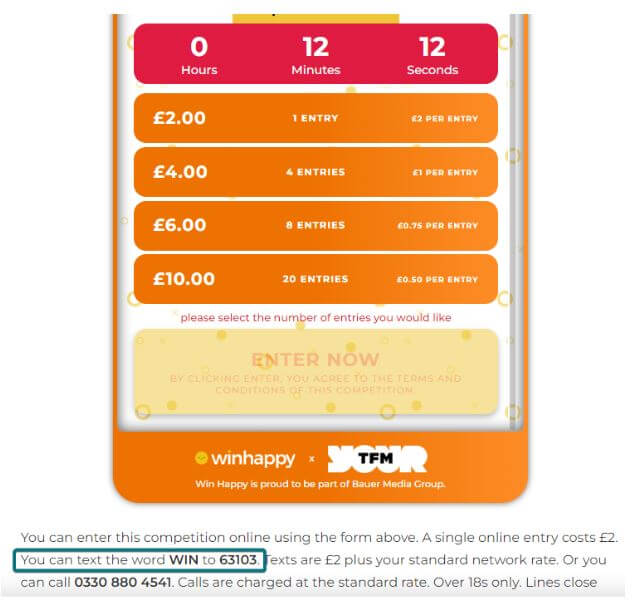
With entry comes the option to sign up to receive marketing messages:
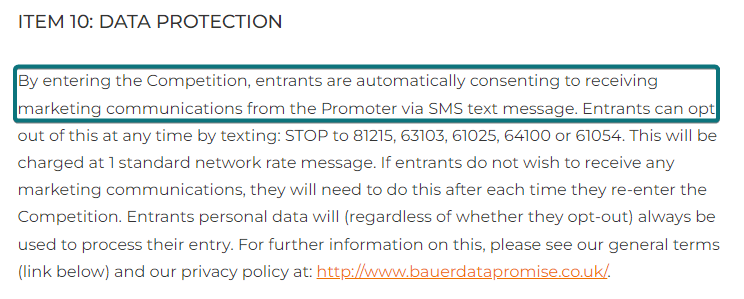
It’s a simple process with a good incentive.
Other incentives include:
- Promotions (e.g. free swag or early access to sales)
- Discount codes (e.g. 10% off your first purchase)
- Trust offers (e.g. account details, order confirmation, delivery updates, etc.)
It’s also good practice to get text confirmation before you start sending. This is known as a double opt-in and works as an added layer of compliance. It also stops you wasting money sending texts to people who don’t want to hear from you.
A simple way to get it is to thank a customer for signing up (or entering a competition or making a purchase) and ask them to confirm their opt-in by replying “Yes” or “No.”
If they respond “No” or don’t reply, don’t text them again.
2. Choose an SMS marketing platform
An SMS marketing platform is the software that lets you send bulk SMS, so you can reach multiple customers at the same time.
There’s no shortage of this kind of software on the market, Text Marketer being one of them. So, you don’t have to look far to find one.
Each platform has different features and functions to weigh up, but there are a few non-negotiables. To help you run worthwhile campaigns, a platform should have:
- Easy-to-use editing tools and a shallow learning curve
- Text personalisation to easily add customer names and details
- Compliance features such as Sender ID and opt-out messaging
- Message scheduling to send texts at specific times
- Contact list grouping to segment customers (e.g. by location, age, gender, etc.)
- Analytics features to track text message delivery and replies
- Message automation for common events (e.g. abandoned cart, birthdays, survey replies)
- Integration with your existing marketing software
- The ability to add and manage additional users
- Tier 1 network connections for fast, reliable message delivery
- Good technical and general support
- Low-cost bulk SMS rates with no hidden fees
While it’ll take time to perfect your text marketing strategy, with a good platform, you should be able to sign up, buy credits and run your first campaign in minutes.
3. Think about the customer journey
We’ll get to the nuts and bolts of what a good SMS marketing message looks like soon.
But something you’ll want to think about before sending is what your customer wants to achieve.
The customer journey is the steps a customer takes from first becoming aware of your business to making a purchase, and eventually becoming a loyal customer.
Here’s what it looks like:
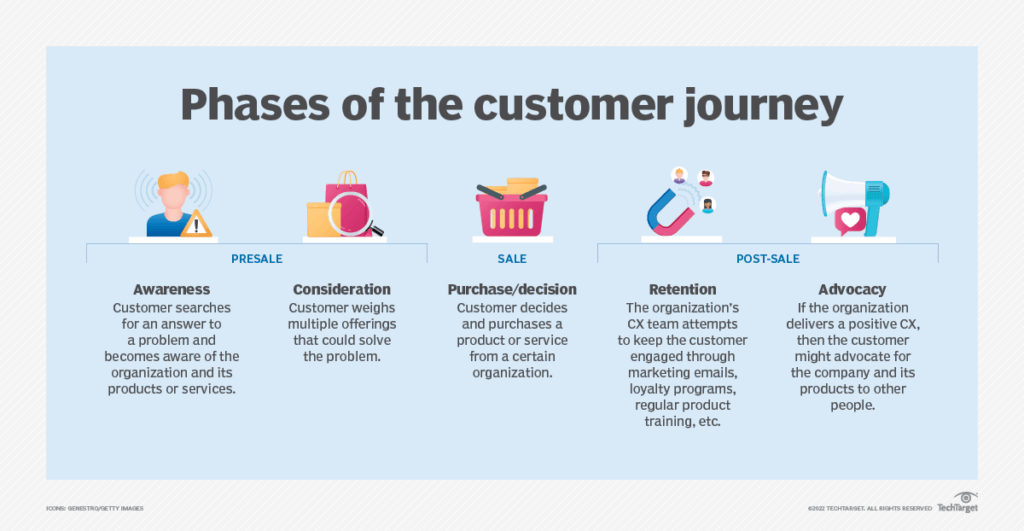
Understanding which stage your customer is at makes it easier to send the right message at the right time. And stops you from blanket sending random texts.
Keep messages relevant by grouping customers and using automation.
For example, automating welcome texts for new subscribers lets them know they’ve signed up and sets the tone for future interactions.
Similarly, grouping existing customers lets you send them offers that aren’t relevant to new subscribers.
Check out how SMS can keep customers moving in the right direction in our guide to mobile journeys.
4. Pick the best time to send
Figuring out the best time to send gets easier when you start collecting data and can see who has and hasn’t responded to your messages.
But you can get good engagement early on by thinking about the context of your message.
For example, if you’re running a discount on pizzas on Friday night, send the text on Friday afternoon when people are likely thinking ahead to the weekend.
If you’re promoting a flash sale, send the text on a weekend morning when people are likely to be using their phones, versus a weekday morning when people are more likely to be focused on work.
Keep it simple. Think about your own habits. When do you prefer to receive different kinds of texts? The chances are others feel the same way.
5. Measure, tweak and improve
Like all marketing, SMS is trial and error. Not every text you send will be a hit, but that’s what data is for: to tell you what’s good and what needs to improve.
Experiment with different messages and times and use the results to fine-tune your strategy.
For example, if you’re running a special offer, test it by sending two slightly different texts and analyse which gets the most replies. You can change the first line, the call-to-action, the link, or short code.
Choose one thing at a time to focus on until you figure out the best combination.
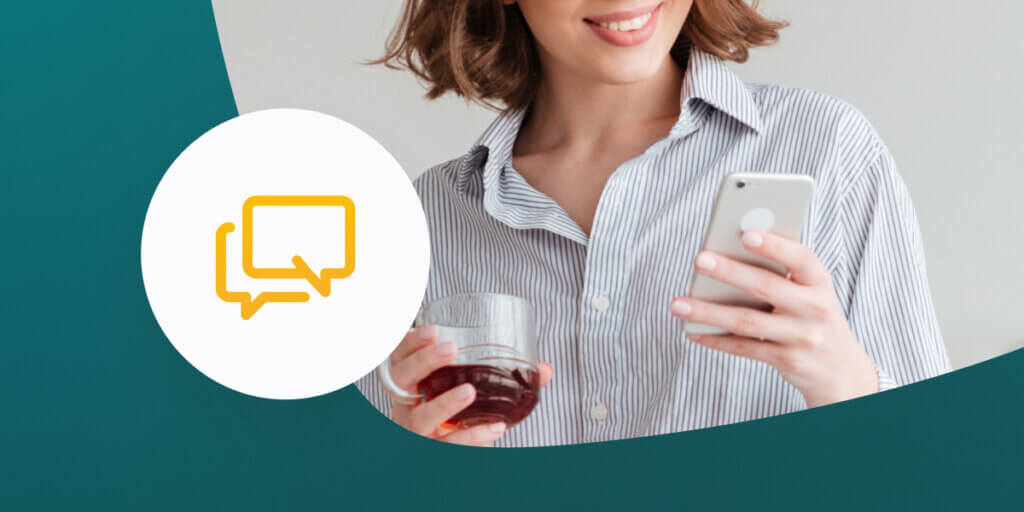
SMS messaging best practices
You know how we’ve just talked about the importance of relevance, context and timing? Well, none of that matters if the text itself doesn’t engage the customer.
Here’s how to write texts that people want to read.
Keep messages short and sweet
One text message equals 160 characters. You can go over this (it’ll cost you extra credits if you do), but you shouldn’t.
SMS works because messages are short and easy to read. Use the restrictions to tighten your copy.
Figure out what you want to say and say it as simply as possible.
For example, Papa Johns used Text Marketer to promote a price-based offer:
“Any Pizza, any size, including our massive 16″ – £6.99 collection or £8.99 delivery.”
In 83 characters, the text tells you everything you need to know, with enough space to include a shortened link to its website.
The result?
A 33% increase in sales with a return on investment (ROI) of £5.30 for every £1 spent.
Make texts personal
Personalising your messaging turns a text that’s for lots of people into a text that’s for one person.
Of course, you’re sending that same message to everyone on your list, but as far as the customer is concerned you’re talking specifically to them. Which is exactly what they want.
71 percent of consumers expect companies to deliver personalised interactions and 76 percent get frustrated it doesn’t happen.

If you deliver it, it can make a big difference to businesses: 5 to 15% increased revenue, 50% lower acquisition costs and 30% better marketing ROI.
Personalise your marketing where possible by using your subscribers’:
- First name
- Age and gender
- Birthday
- Location
- Interests
- Purchase history
Get the balance right
When a customer gives you their phone number, they expect you to treat it with respect. Any lack of consideration and you’ll lose them. And since it’s easy to opt out you’ll likely only get one chance.
So, don’t bombard customers with texts and keep promotional messages to a minimum.
As a rule of thumb, use the 80/20 rule (aka Pareto Principle).
Make 80% of your messages informational. For example, updates on orders, appointment reminders or asking for feedback.
The remaining 20% can be promotional: sales, discounts, special offers, etc.
You want the customer to feel like texts are mostly relevant and useful. This helps you build trust so that promotional messages, when they do arrive, are welcomed.

8 SMS marketing examples to inspire your next campaign
The best way to learn anything is through examples. So here are some from the Text Marketer template library and elsewhere to inspire your SMS marketing strategy.
1. The time-sensitive offer text message
The speed of SMS makes it a great channel for grabbing attention and getting people to act fast. For big promotions or limited-time offers, use urgency and scarcity to create FOMO (fear of missing out).
For example:
- Last chance
- Ends tomorrow
- Shop now
- Only 5 hours left

2. The birthday text message
Emotional connection to a business is responsible for around 43% of perceived value. What does this mean?
Customers are more likely to choose you over a competitor if you have a good relationship with them.
Use your sign-up form or checkout process to collect a customer’s date of birth and send birthday texts. It’s a simple way to show you’re thinking of them and reward loyalty with free stuff or discounts to keep them coming back.

3. The exclusive offer message
An exclusive offer is another easy way to reward loyalty is to show customers they’re special.
Subscriber-only discounts, early access to sales and other text-only perks reaffirm a customer’s reason for signing up, while making them feel valued.

4. The customer survey text message
SMS surveys are an effective way to get real-time feedback on various aspects of your business. Use them to learn about your products, services, customer support, and communication methods.
There are several ways to do this:
- Text a link to an online questionnaire for customers to submit answers
- Use a reply number to ask questions and receive text replies (follow-up questions can be tailored depending on the reply)
- Send Net Promoter Score (NPS) surveys that ask customers to rate you (e.g. between 1 and 5 or from ‘Very good’ to ‘Very poor’)
As well as helping you improve, asking customers for their experiences shows you’re thinking of them, positioning you as a business that values its community.
5. The customer service text message
Remember, SMS marketing should be more informational than promotional. Use customer service text messages to update and reassure people on issues that affect them.
For example, order updates, a change of opening hours, stock updates, or any issues with systems, service or staffing.
Clear communication shows your human side and helps to strengthen relationships.

6. The welcome text message
A well-timed welcome message capitalises on new subscriber interest, giving you a chance to introduce your business and keep them invested.
A welcome message can be a one-off introduction or part of a series that nurtures customers over several weeks.
Here’s how a series might look:
- A sign-up confirmation message
- A reminder of what to texts expect and a special intro offer
- An intro to your brand values to build affinity
- A product recommendation
- Social proof (e.g. a review) to build confidence
- A reminder of their intro offer intro
The slow build is a great way to set expectations and build trust over time. It also gives you more chances to engage new subscribers. If they don’t reply to your first text, there are several other opportunities to get their attention.
Here’s an example from Vodafone:

7. The upsell/cross-sell text message
67% of customers say they want businesses to send relevant products/service recommendations. Upselling and cross-selling do exactly this.
It’s a way to increase the value of customers by suggesting products they might like based on previous activity. For example, if a person buys a phone, you might recommend a case or a better contract.
Stick to products or services that are of a similar price or lower to avoid putting customers off. And use discounts as an incentive to purchase.

8. The cart abandonment text message
Around 70% of all online shopping carts are abandoned. So, for every 100 customers, 70 leave without buying. Use cart abandonment texts to tempt them back while the product is fresh in their mind.
Include the shopper’s name, product name and a link to the product so they can quickly return to the checkout.
You might also want to sweeten the deal with a discount code or benefit like free shipping to convince them to complete the purchase this time around.

Want more examples? Check out the Text Marketer SMS Template Library for 50+ copy-and-paste messages.
Get started with SMS marketing
SMS marketing is a fast and easy way to spread the word. More importantly, it works. Customers prefer texts and act when they receive them. Send the right message at the right time and there’s a good chance you’ll reap the rewards.
Ready to launch your first SMS campaign?
Sign up for Text Marketer’s free trial and get double credits on your first order up to 10,000.

Do SMS marketing on the platform where your credits never expire
Pay for what you need, keep what you pay for.
No contract. No sign up or set up fees


